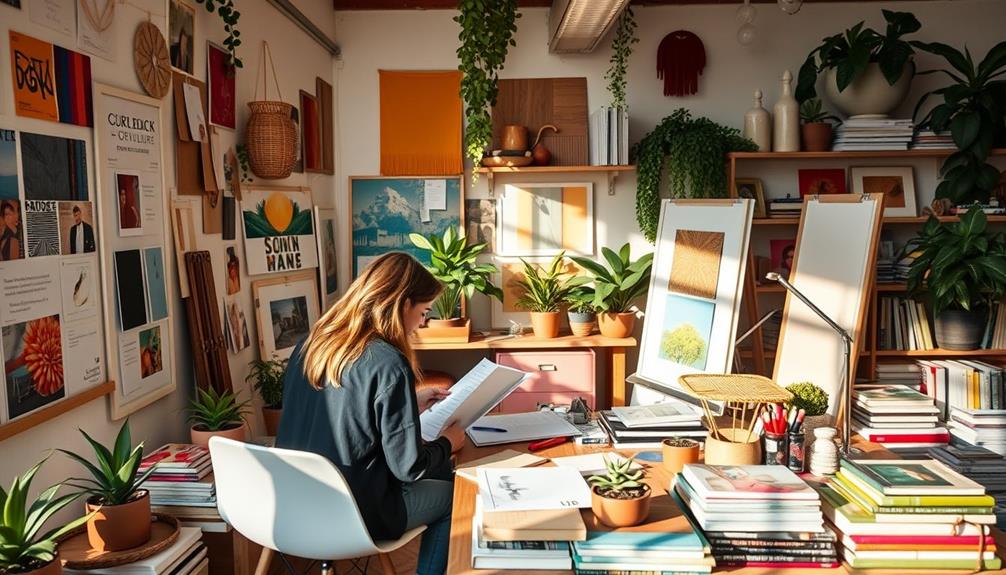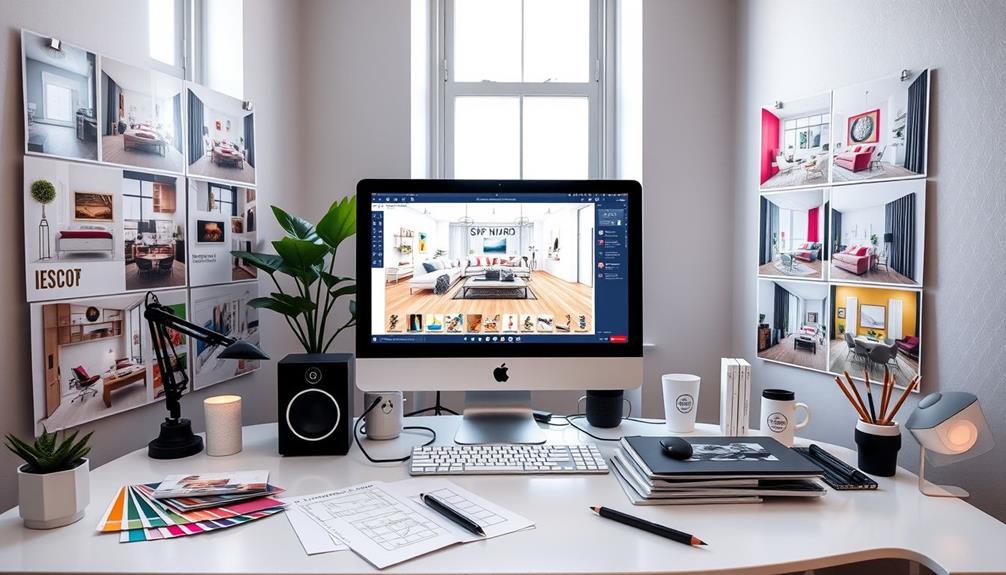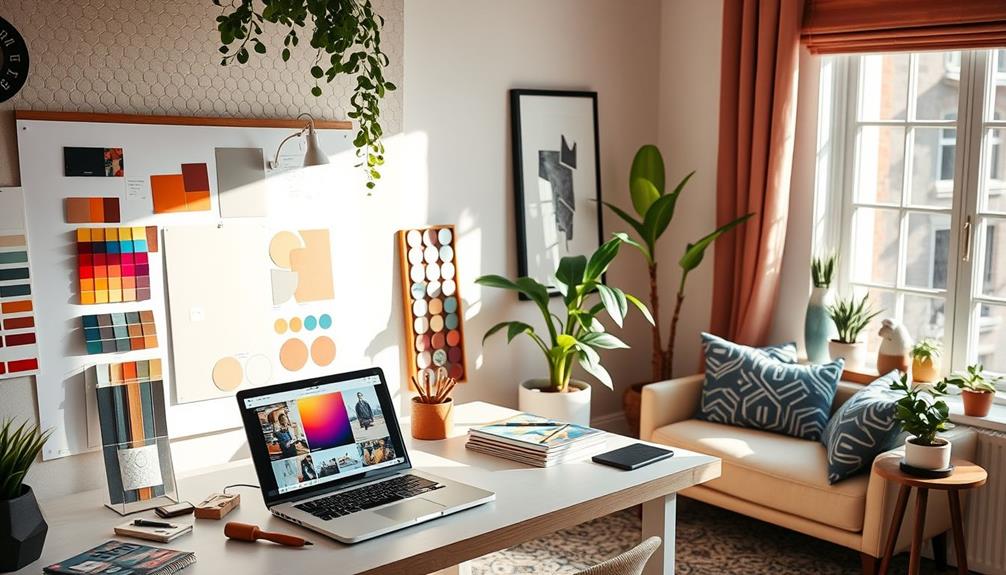To grow your interior design business, focus on leveraging diverse marketing strategies while enhancing client experiences. Utilize Google My Business and SEO to boost your visibility. Engage in local networking and create referral programs to build trust and gain direct clients. Personalize your communications through direct mail and email marketing to strengthen relationships. Don't forget to keep learning about industry trends and innovations. Continuous development will keep you competitive. By adapting your services to market demands and listening to your clients, you'll be set for success. Discover more strategies that can elevate your business further. Consider hosting workshops or webinars to showcase your expertise and connect with potential clients. Utilize social media platforms to share your work and engage with a wider audience. By staying updated on the latest interior design trends and incorporating them into your services, you can position yourself as a leader in the industry. For more interior design business promotion tips, consult industry experts and seek out mentorship opportunities.
Key Takeaways
- Utilize diverse marketing channels, including SEO and blogging, to enhance visibility and attract clients effectively.
- Implement referral programs and engage in local communities to capitalize on word-of-mouth marketing.
- Focus on client relationship management by providing personalized experiences and regular updates to boost satisfaction and loyalty.
- Continuously invest in professional development through courses and networking to stay competitive in the evolving interior design market.
- Monitor financials and explore diverse revenue streams to ensure stability and growth in your design business.
Understanding Marketing Channels

In today's competitive interior design landscape, understanding your marketing channels is vital for attracting the right clients. Simply relying on social media to reach potential clients can limit your opportunities; you might miss out on ideal clients who aren't active on platforms like Instagram.
To enhance your marketing strategy, consider implementing keyword clustering and topic clustering, as it can improve user experience and content discoverability. Diversifying your marketing efforts guarantees you're visible wherever your audience is looking.
Setting up a Google My Business account is a game-changer for local visibility. Regular updates and positive reviews greatly enhance your business's ranking in local search results, making it easier for potential clients to find you.
Alongside this, investing in SEO remains essential. By focusing on fresh content, recent reviews, and keyword optimization, you can improve your discoverability and attract more clients.
Don't overlook the power of blogging; it's an excellent way to engage with clients and boost your SEO. Well-chosen topics not only establish trust but can also draw traffic from platforms like Pinterest.
Effective Content Creation

Creating engaging content is essential for boosting your visibility and attracting potential clients.
By blogging regularly and sharing valuable insights, you can enhance your SEO and drive more traffic to your site.
Additionally, effective email campaigns with downloadable resources can help you grow your audience and establish trust with your brand.
Blogging for Visibility
Blogging serves as a powerful tool for enhancing your interior design business's visibility online. By regularly creating fresh content, you improve your SEO, which boosts your website's ranking in search engine results. This is essential for attracting potential clients who are searching for design services like yours.
Incorporating engaging content like crazy games can also create a unique angle to your blog, making it more appealing to your audience.
Choosing well-thought-out blog topics that incorporate relevant keywords can greatly enhance your discoverability. Not only does this establish your authority within the interior design niche, but it also builds trust with potential clients. When you share valuable content, you encourage them to reach out for services, knowing you're knowledgeable in your field.
Additionally, your blog posts can be repurposed for social media platforms, driving more traffic to your website and increasing engagement with your audience. Consistently posting high-quality content can lead to impressive growth in website traffic.
In fact, businesses that blog regularly see 55% more visitors than those that don't.
Engaging Email Campaigns
Building on the visibility gained from blogging, engaging email campaigns can take your interior design business to the next level by fostering deeper connections with clients. By leveraging email marketing, you can create personalized messages that resonate with your audience, leading to a 26% increase in open rates.
Additionally, utilizing email marketing software selection is essential for small business success, allowing you to efficiently reach your target audience. Use compelling subject lines to capture attention and entice subscribers to read further.
Incorporating visuals in emails, like stunning project photos or helpful design tips, can greatly boost engagement. Emails featuring images see a 42% higher click-through rate, making them more effective at driving action.
Consistency is also critical; maintaining a regular email cadence, such as monthly newsletters, keeps your brand top-of-mind for potential and existing clients.
Don't forget to offer exclusive content. Providing subscribers with valuable resources, like design guides or early access to new services, enhances subscriber engagement and retention.
Enhancing Client Experience
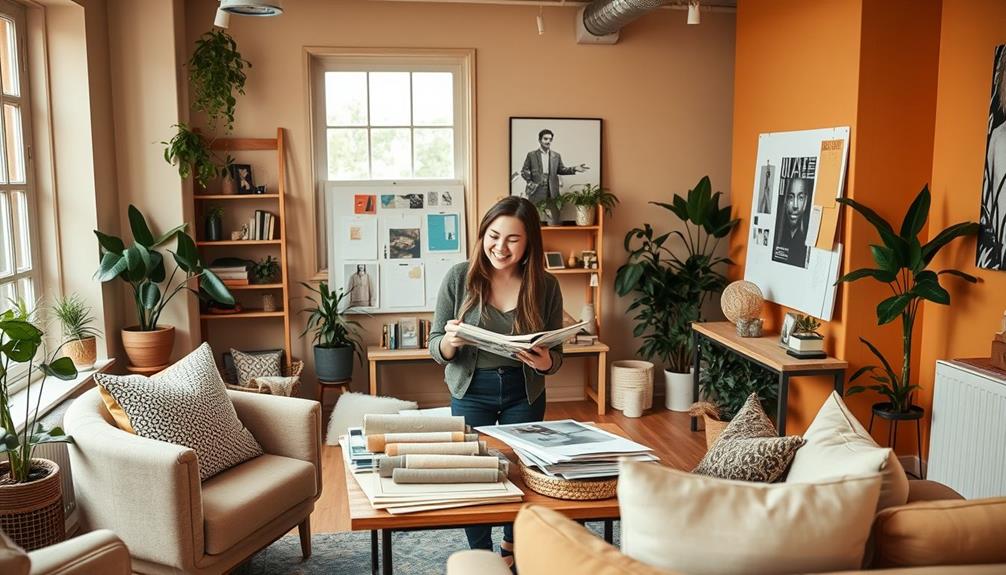
Enhancing the client experience in interior design is essential for fostering lasting relationships and driving business growth. When you create a stress-free and enjoyable design process, you can see a notable 70% increase in referrals. Satisfied clients love to share their positive experiences, which can greatly expand your reach.
Engaging clients throughout projects by providing regular updates and involving them in decision-making can boost client satisfaction ratings by 50%. Incorporating personalized touches, like welcome packages or handwritten notes, helps create a luxurious client experience, enhancing loyalty and increasing the likelihood of repeat business by up to 60%.
Utilizing efficient project management tools streamlines communication and collaboration, resulting in a 40% reduction in project delays and building client trust. Moreover, actively seeking and incorporating client feedback during and after projects can improve overall satisfaction scores by 30%.
This guarantees your future services align closely with client expectations, making them feel valued and heard. By focusing on these strategies, you'll not only enhance the client experience but also pave the way for a thriving interior design business.
Networking for Referrals

While many interior designers focus solely on their creative skills, networking for referrals is just as essential for your business growth. Building relationships with both upstream and downstream referral sources, like real estate agents and contractors, can greatly boost your chances of receiving referrals.
By participating in local industry events and networking groups, you can connect with potential referral partners while enhancing your visibility in the community.
Establishing a structured referral program that incentivizes past clients to refer new clients can turn satisfied customers into active promoters of your services.
Don't forget to express gratitude; regular follow-ups and thank-you notes strengthen relationships with referral partners and encourage ongoing collaboration.
Engaging in community initiatives or collaborating with local businesses can further increase your brand awareness and foster mutual referrals, enhancing your credibility in the local market.
By actively participating in these networking opportunities, you're not only expanding your professional circle but also laying the groundwork for long-term success.
Ultimately, the stronger your network, the more your interior design business can thrive.
Local Marketing Strategies
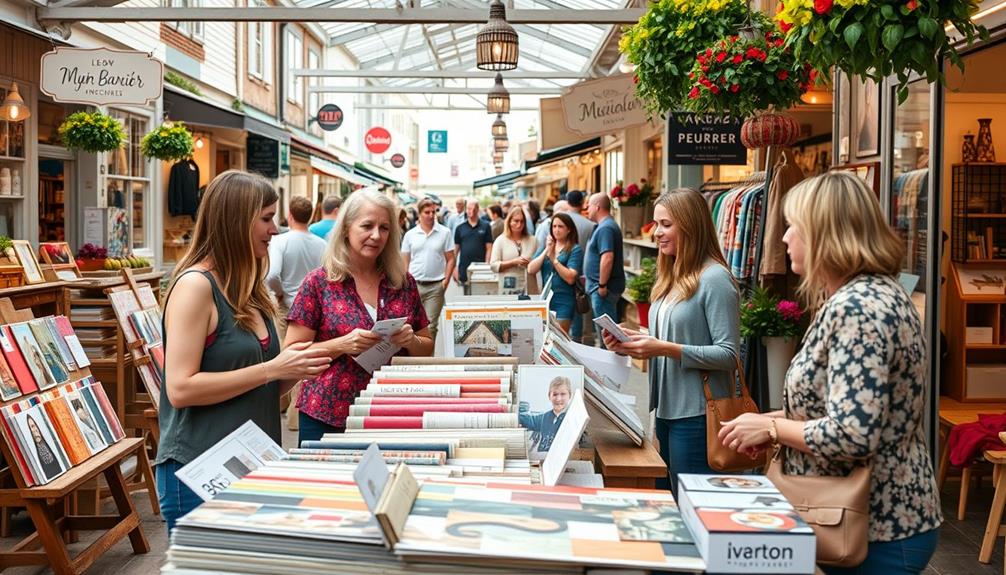
To effectively grow your interior design business, you need to embrace local marketing strategies that resonate with your community. Start by implementing a referral program that incentivizes satisfied clients to recommend your services to friends and family. This taps into the powerful word-of-mouth marketing that local communities trust.
Additionally, consider leveraging resources like the Études Architect App for enhanced collaboration with your clients and other professionals in the industry.
Engage with community members through local Facebook groups. These platforms can greatly enhance your brand visibility within your target market.
Additionally, consider hosting local events or workshops to showcase your design expertise. This allows potential clients to interact with you directly, fostering trust and connection.
Collaborate with nearby businesses, such as real estate agents or home improvement stores. Joint promotional efforts can expand your reach and attract new clients through shared audiences.
Don't overlook the power of press features in local magazines or newspapers; they can establish credibility and gain exposure for your work.
Focusing on a Niche
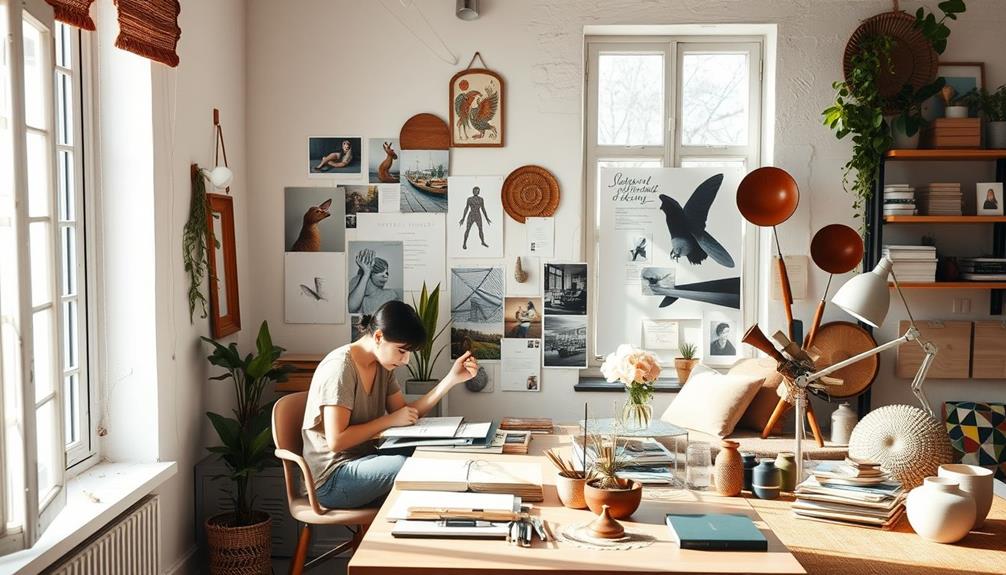
Building on your local marketing strategies, focusing on a niche can greatly elevate your interior design business. By specializing in areas like sustainable design or luxury residential projects, you streamline your marketing strategy, attracting ideal interior design clients who appreciate your expertise.
This targeted approach not only differentiates your services in a competitive market but also enhances your branding. When you communicate a clear niche, you boost your visibility in search engines, making it easier for clients actively seeking those specialized services to find you.
Research shows that niche-focused designers often enjoy higher client satisfaction, as clients perceive them as experts. This perception can lead to increased referral rates and repeat business, creating a loyal client base that values your understanding of their specific needs and preferences.
Narrowing your focus allows you to allocate resources more effectively, resulting in higher quality work and better overall project outcomes. Ultimately, by honing in on a niche, you position yourself as a go-to expert, fostering deeper connections with clients and elevating your interior design business to new heights.
Leveraging Client Relationships
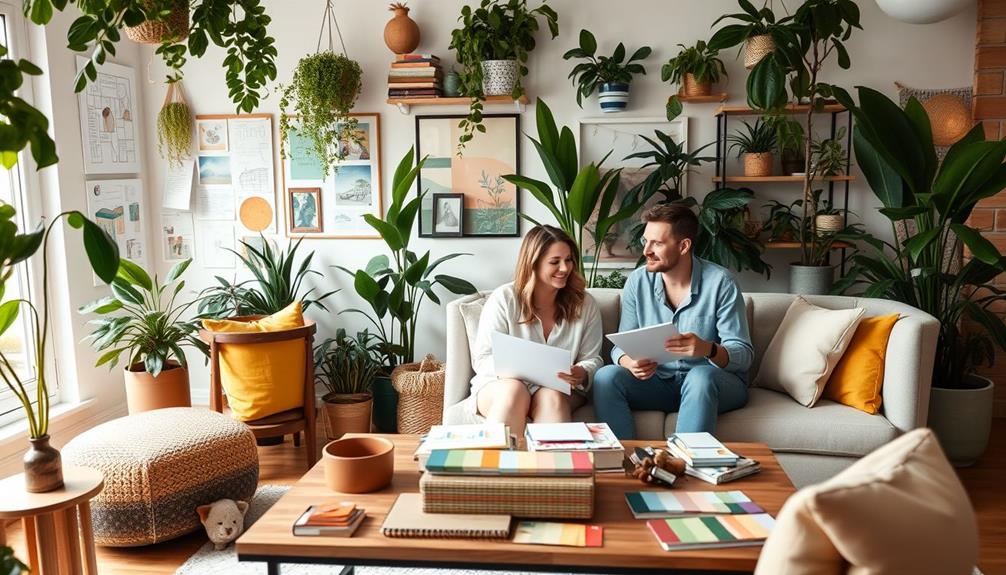
Nurturing client relationships is key to the success of your interior design business. Retaining existing clients costs considerably less—about five times less—than acquiring new ones.
By engaging with past clients through regular check-ins and updates, you can encourage repeat business, with a 30% increase in the likelihood of new projects when you reach out annually or biannually.
Celebrate milestones like project anniversaries or renovations to prompt referrals, tapping into the power of word-of-mouth marketing.
Personalized communications, such as sending holiday cards or exclusive offers, can enhance client loyalty and boost referrals by up to 25%.
Implementing a structured referral program that rewards past clients for successful leads can further incentivize them to promote your services.
This creates a win-win situation—your clients feel appreciated, and you expand your clientele.
Utilizing Direct Mail

Direct mail can be a game changer for your interior design business, especially when you target specific neighborhoods.
By using personalized communication strategies, like handwritten notes or tailored offers, you can create a stronger connection with potential clients.
Plus, effective mail campaign techniques can help you stand out and drive immediate responses, making your outreach more impactful.
Targeted Neighborhood Outreach
Harnessing the power of personalized direct mail can transform your outreach efforts in targeted neighborhoods. By sending tailored materials, like handwritten notes or welcome packets, to new homeowners, you create a direct line of communication that establishes rapport with potential clients.
Direct mail campaigns can yield a response rate of 4.9% for targeted lists, considerably outperforming the 0.12% average for email marketing. This makes direct mail a more effective strategy for local outreach.
Utilize geographic data to pinpoint neighborhoods with high property turnover, focusing your efforts where new clients are most likely to need interior design services.
Don't forget to include promotional incentives, like a free consultation or discount, in your mail pieces—these can greatly increase engagement and motivate recipients to reach out for your services.
To assess the effectiveness of your marketing efforts, track your direct mail campaigns using unique URLs or dedicated phone numbers. This allows you to refine your approach for future outreach, ensuring you connect with even more potential clients in those targeted neighborhoods.
Personalized Communication Strategies
Building on the power of targeted neighborhood outreach, personalized communication strategies can greatly enhance your engagement with potential clients.
Direct mail campaigns are an effective way to create genuine connections and enhance your branding in specific neighborhoods. Here are some ideas to contemplate:
- Handwritten notes that convey your personal touch and attention to detail
- Welcome packets that showcase your interior design services and portfolio
- Congratulations cards for new homeowners, positioning you as a valuable resource
- Postcards featuring local construction projects, appealing to builders and architects
- Visually striking materials that capture attention and drive inquiries
Effective Mail Campaign Techniques
When it comes to effective mail campaigns, utilizing direct mail can greatly amplify your outreach efforts. Direct mail campaigns boast a response rate of 4.4%, far surpassing the mere 0.12% of digital channels.
To maximize this potential, focus on personalizing direct mail. Handwritten notes or tailored offers can increase engagement and response rates by up to 30%.
Target new homeowners in specific neighborhoods; they're often enthusiastic for design services to transform their newly acquired spaces. This targeted approach enhances your likelihood of conversion considerably.
Incorporate digital marketing efforts into your campaigns by adding QR codes that link to your website or social media profiles. This bridges the gap between traditional and digital outreach, encouraging recipients to connect with your brand online.
Additionally, implement a referral program through your direct mail pieces. Offering incentives for satisfied clients who refer friends and family can effectively boost word-of-mouth marketing, expanding your client base.
Exploring Additional Resources
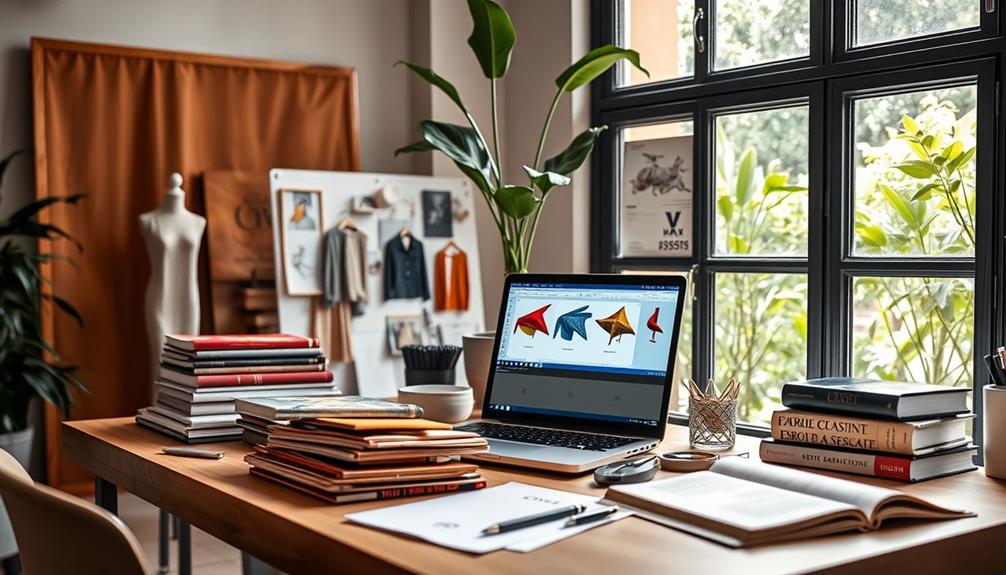
To thrive in the competitive world of interior design, you need to tap into a variety of resources that can fuel your growth and keep your skills sharp.
Here are some essential resources to evaluate for your interior design business:
- Online courses to stay updated with the latest trends and best practices.
- Houzz Pro for access to industry-specific content and effective lead generation services.
- Professional organizations that provide networking opportunities and valuable insights.
- Trade shows to explore new products and connect with industry peers.
- Project management tools to streamline operations and enhance service delivery.
Continuous Learning and Growth

In the dynamic field of interior design, continuous learning acts as a cornerstone for success. Staying updated with industry advancements is vital, and online courses offer flexible options to enhance your skills and knowledge. Engaging in Continuing Education Units (CEUs) not only fulfills licensing requirements but also keeps you competitive; many top vendors provide IDCEC-certified courses that can elevate your expertise.
Additionally, understanding the importance of AI advancements in various industries can help you integrate new technologies into your design processes, guaranteeing your work remains innovative and relevant.
Attending workshops and seminars allows you to gain hands-on experience and insights into new design techniques that you can apply directly to your projects. These practical learning opportunities are essential for refining your craft.
Additionally, networking at trade shows and industry events is invaluable. Sharing knowledge and learning from peers can strengthen your professional relationships and open doors for collaboration.
To guarantee you're committed to professional growth, set quarterly and annual learning goals. This approach helps you adapt to changing market trends and client preferences effectively.
Conclusion
In growing your interior design business, you'll find that creativity meets strategy. Embrace the power of marketing channels while you craft compelling content. Enhance your client experience as you build strong networks for referrals. Local marketing can flourish alongside nurturing client relationships. Don't shy away from direct mail, even in a digital age. Explore additional resources and commit to continuous learning, and you'll see your business thrive in a competitive landscape, harmonizing innovation with tradition.
